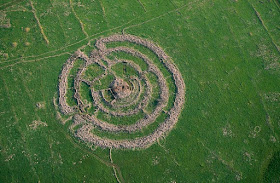Well, the ancient megalith
monument, comprising of concentric stone circles and a tumulus at the center.
However, it looks extremely impressive from the air, and barely visible from
the ground. The megalith monument walls are just 6 feet high; though the central
mound is higher. The ancient place is located in the middle of a bare expanse
of field in the Israeli-occupied portion of the Golan Heights. This is large
stone monument went ignored for many centuries. The stone monument was captured
from Syria in 1967, and then it was discovered by Israeli archeologists after territory
was captured.
This is also called Rujm el-Hiri (means
"stone heap of the wild cat) is dated to about 3000 BC, which makes it
contemporary to famous England's Stonehenge. The Syrian people also called it
Rujm el-Hiri, in Arabic while Hebrew it is named “Gilgal Refaim” that means the
“wheel of Refaim”, where “Refaim” is an ancient race of giants. It is also mentioned
in the Bible that supposedly lived in Iron Age Israel. The word “Refaim” in Modern
Hebrew also means "ghosts" or "spirits". This reference to
“giants” and “ghosts” alludes to its huge size, however the stone circle is 160
meters across as well as to the secret of who built the multifaceted and the
purpose behind it. This stone monument is often referred to as the
"Stonehenge of the Levant."
The megalith structure consists
of a large circle of basalt rocks, comprising four smaller concentric circles,
each getting gradually thinner. Therefore, same as most megalith sites, there
is no record of who built Rujm el-Hiri or for what purpose. The circles walls are
connected by unevenly placed smaller stone walls perpendicular to the circles. Thus,
at the center is a heap of rocks, recognized as a cairn. This cairn is just 5
meters tall, and their tallest part of the whole structure. Another theory believes
that “Rujm el-Hiri” was an astronomical calendar. Although, it is projected
that “Rujm el-Hiri” contains more than 40,000 tons of basalt rocks.
Moreover it seems that in the
year 3000 BCE, the longest day, the first rays of the sun shone through the
opening in the north-east gate. However, the shown alignment is not impeccable,
that is assumed to be a sign of the lack of exact knowledge or the absence of precise
architectural tools. Moreover, another theory is that the “Rujm el-Hiri” is built
for a tomb purpose even though no human remains have been found. The incomprehensible
site lies close to Israeli military camps and is so accessible only on holidays
and weekends.





